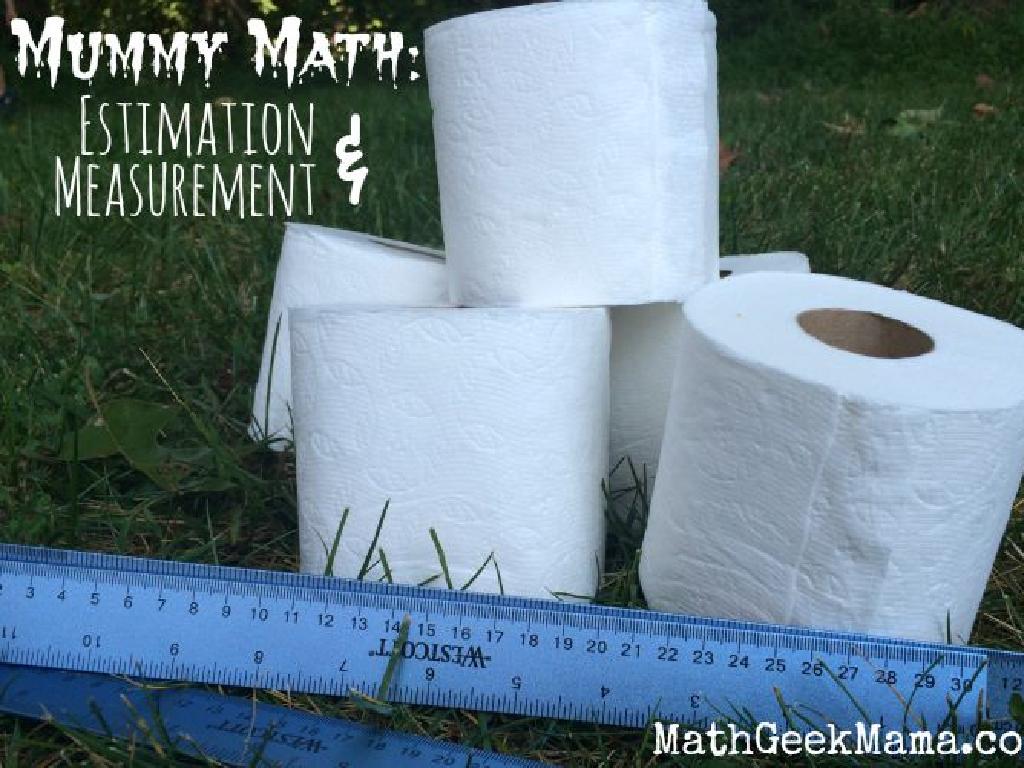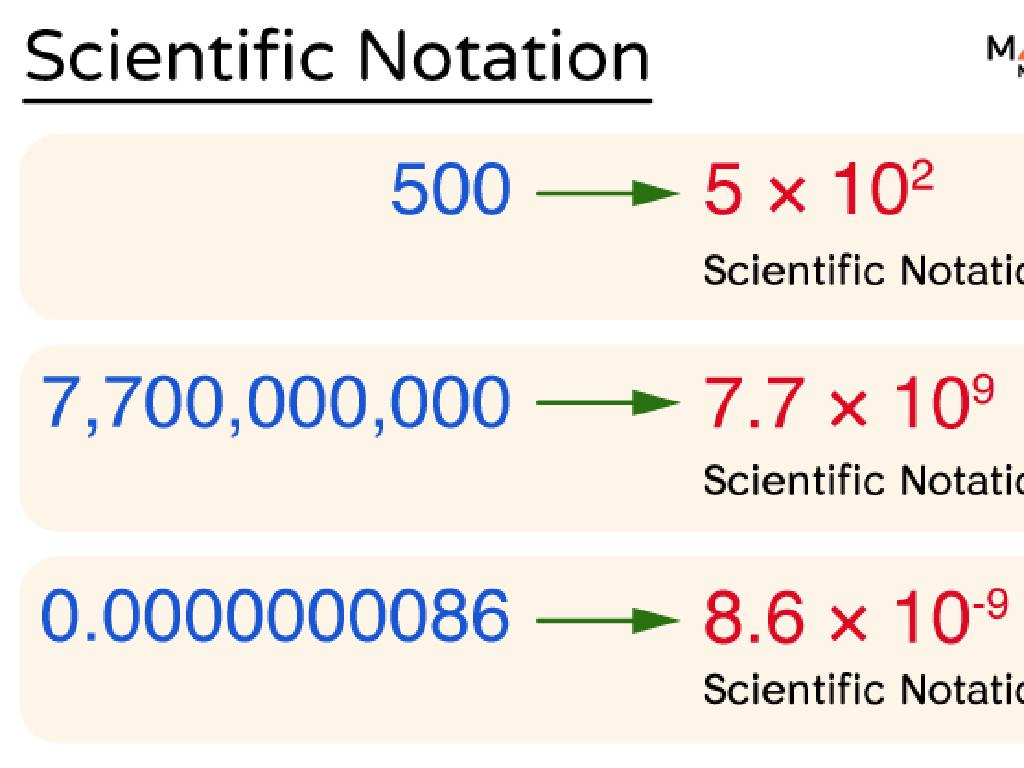Before, After, And Between - Up To 10
Subject: Math
Grade: Kindergarten
Topic: Counting Forward And Back To 10
Please LOG IN to download the presentation. Access is available to registered users only.
View More Content
Welcome to Counting!
– Greetings, young mathematicians!
– Today’s fun with numbers!
– Learn ‘before’, ‘after’, ‘between’
– What comes before 2? What’s after 3? Which number is between 4 and 6?
– Counting up to 10
– Practice counting 1 to 10 forwards and backwards
|
This slide is designed to introduce kindergarten students to the concepts of ordinality and counting within the range of 1 to 10. Start the lesson with a warm and engaging greeting. Make the learning process playful, as children this age learn best through play and interaction. Explain the terms ‘before’, ‘after’, and ‘between’ using simple examples and interactive activities. Use physical objects like blocks or counters to visually demonstrate the sequence of numbers and their relationships. Encourage the children to participate by asking questions and guiding them to count out loud together. This will help them understand the order of numbers and prepare them for more advanced mathematical concepts.
Understanding Before, After, and Between
– ‘Before’ means the previous number
– If we have the number 5, the number before is 4
– ‘After’ means the next number
– If we have the number 5, the number after is 6
– ‘Between’ means the middle number
– The number 5 is between 4 and 6
– Practice with numbers up to 10
|
This slide introduces the concepts of before, after, and between with numbers up to 10. It’s crucial for kindergarteners to understand these terms as they form the basis for number sequencing. Use simple, clear examples like counting fingers or toys to illustrate these concepts. For ‘before’ and ‘after’, you can use a number line or counting objects. For ‘between’, place an object in the middle of two others to show the concept visually. Encourage the students to practice by asking what number comes before, after, or between with various numbers up to 10. This will help solidify their understanding of number order and prepare them for more advanced math concepts.
Let’s Count Before!
– Understanding ‘before’ in numbers
– Which number is before 5?
– Before 5 on the number line, we find 4
– Use a number line to find before
– A number line helps us see the order of numbers
– Practice with numbers before 3 and 8
– Let’s find out what’s before 3 and 8 together
|
This slide is aimed at helping Kindergarten students understand the concept of ‘before’ in the context of numbers up to 10. Start by asking the students which number comes before 5 to engage them. Then, demonstrate using a number line how to visually identify the number that comes before a given number. For practice, ask the students to apply this concept by finding the numbers that come before 3 and before 8. Encourage them to use their fingers or counters if they need a tactile method to find the answer. This activity will help reinforce their understanding of numerical order and prepare them for more complex counting tasks.
Let’s Count After!
– Understanding ‘after’ in numbers
– Number after 2 is 3
– On a number line, 3 is right after 2
– Practice with different numbers
– What’s after 1? What’s after 6?
– Use a number line for help
– A number line shows the order of numbers
|
This slide is aimed at helping Kindergarten students understand the concept of ‘after’ in the context of numbers up to 10. Start by explaining that ‘after’ means the next number in the sequence. Use a number line as a visual aid to show that 3 comes after 2. Engage the students in a practice activity where they identify the number that comes after 1 and after 6, using the number line to find answers. Reinforce the concept by asking them to find other ‘after’ numbers on the number line. Encourage participation and praise correct answers to build confidence.
Finding the Number Between
– Understanding ‘between’ numbers
– Example: Between 4 and 6
– What comes after 4 but before 6?
– It’s the number 5!
– 5 is right in the middle!
– Let’s practice with more numbers
– Try finding between 2 & 4, and 7 & 9
|
This slide is aimed at helping Kindergarten students grasp the concept of finding the number that comes between two other numbers. Start by explaining the term ‘between’ with the help of a simple example, such as what number comes between 4 and 6. Once the students understand the concept with the help of the example provided, encourage them to practice with other number pairs. Suggested activities for practice could include using number lines, counting objects, or playing a game where students stand in a line and identify who is between them. The goal is to make the concept as interactive and engaging as possible.
Counting Forward Up to 10
– Counting forward: 1 to 10
– Start at 1 and go up to 10, one number at a time
– Let’s count together aloud
– We’ll count as a class: 1, 2, 3, …, 10!
– Practice counting with items
– Use objects like blocks or fingers to count
– Counting is fun and easy
|
This slide is designed to introduce kindergarteners to the concept of counting forward from 1 to 10. Begin by explaining what counting forward means and demonstrate by counting aloud from 1 to 10. Engage the students by counting together as a class to reinforce the sequence of numbers. Incorporate a hands-on activity where students can practice counting forward using tangible items such as blocks, beads, or even their fingers to make the learning process interactive and enjoyable. Emphasize that counting is a fundamental math skill that can be fun and is easy to learn with practice.
Counting Backward from 10
– What does counting backward mean?
– It’s like counting down from 10 to 1.
– Let’s count down together: 10 to 1
– We’ll do it as a class: 10, 9, 8, …, 1!
– Now it’s your turn to try!
– I’ll start, and you finish counting after me.
|
This slide is designed to teach Kindergarten students the concept of counting backward from 10 to 1. Begin by explaining that counting backward is the opposite of counting forward it’s like going down a slide or walking backwards. Demonstrate counting down from 10 to 1 out loud, using your fingers to represent each number. Then, invite the students to join in and count with you. After practicing together, encourage each student to try counting backward on their own. This activity helps students understand sequence and prepares them for subtraction. Possible activities include counting backward to simulate a rocket launch, playing a counting game with steps, or using a number line to visually reinforce the concept.
Class Activity: Number Hopscotch
– Play Number Hopscotch game
– Hop on ‘before’, ‘after’, ‘between’
– For example, if I say ‘after 2’, hop on 3
– Listen for my number calls
– Get ready to jump and learn!
|
This interactive activity is designed to help Kindergarten students understand the concepts of before, after, and between with numbers up to 10. Set up a hopscotch grid with numbers 1-10. As you call out instructions, students will hop on the correct number. For instance, if you say ‘before 5’, they should hop on 4. If you say ‘after 3’, they should hop on 4, and for ‘between 6 and 8’, they should hop on 7. This physical activity not only makes learning fun but also reinforces their counting skills. Be prepared with a list of numbers to call out and ensure each student gets a turn. You can also vary the activity by asking students to hop on a number and then call out the ‘before’, ‘after’, or ‘between’ numbers themselves.





